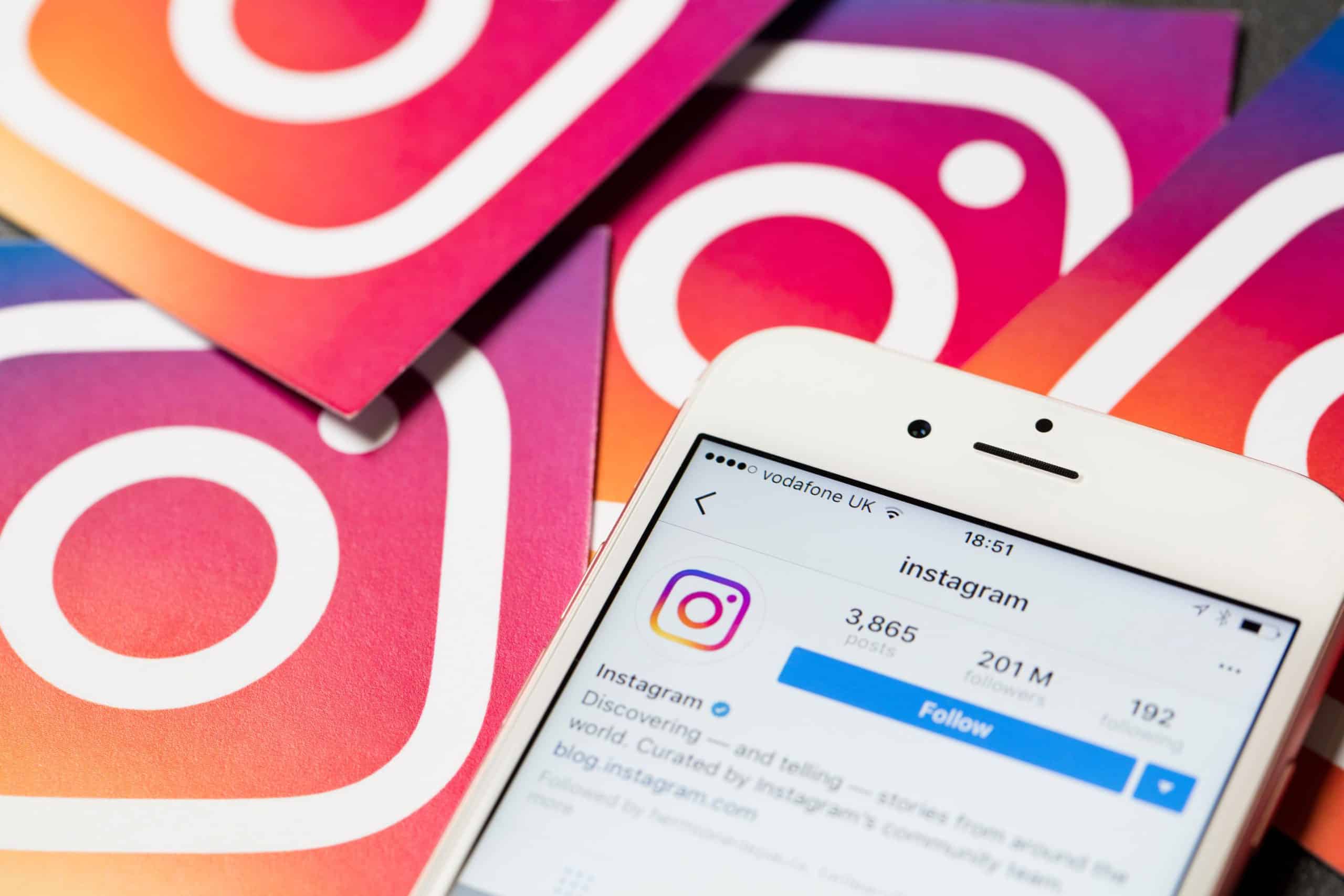Launched in 2010, Instagram started as a simple photo-sharing app. In less than a decade, it became one of the most popular social media platforms in the world, especially for creators and brands that want to grow their audience.
Looking at the history of Instagram gives us a clear picture of how the app evolved to become the tech giant it is today.
This is why we painstakingly gathered the key milestones for the history of Instagram, from its early days as a photo-sharing platform with two co-founders to its current status as a Meta social media company.
Here’s how it weaved its way into the social fabric.
A History of Instagram – Key Dates
- In October 2010, Kevin Systrom and Mike Krieger launched Instagram, hitting one million users in two months.
- Facebook bought Instagram for $1 billion in 2012.
- In 2015, Instagram announced new photo formats in addition to the classic square photos.
- Instagram went through a rebrand in 2016, changing its logo and user interface.
- In 2018, Systrom and Krieger resigned as CEOs of Instagram, and Adam Mosseri, Instagram’s former Head of Product, was appointed Head of Instagram.
- In 2021, Instagram announced its future focus areas: creators, videos, shopping, and messaging.
Who Founded Instagram?
Kevin Systrom and Mike Krieger launched Instagram in October 2010. The duo met while studying at Stanford University. Four years after graduating, they got together to start their own company. In the early days when they were brainstorming ideas, Kevin and Mike worked at a small coworking space in San Francisco.
Their first idea was a company called Burbn, a location-based check-in app similar to Foursquare. In January 2010, Bay Area venture capitalist Steve Anderson became the app’s first investor with a $250,000 injection. Two other venture capitalists, Marc Andreessen and Ben Horowitz, also invested $250,000 in the same round.
Although Burbn didn’t succeed, it had a unique feature other check-in apps didn’t have: a photo-sharing feature. Moving forward, Kevin Systrom and Mike Krieger decided to take Burbn’s unique feature to develop their next app.
As a result, they put the main focus on photos and renamed the app Instagram. With almost 25,000 people signing up within the first 24 hours, Instagram was an instant hit. It reached one million registered users in two months, 7 million in 9 months, and 30 million in 18 months.
In April 2012, Facebook acquired Instagram for $1 billion in cash and stock. After the acquisition, Kevin Systrom and Mike Krieger continued working as the CEOs of Instagram until 2018.
Since 2018, Adam Mosseri has been the Head of Instagram.
If you want to hear more about Systrom and Krieger’s long journey to incredible success, check out their recent interview with TODAY.
Growth and Development of Instagram
Instagram had over two billion monthly active users as of 2023, and is the fourth most popular social network in the world. Its use goes way beyond sharing photos, as a result of the app’s growth and development over the years.
Here’s what happened in the history of Instagram, year by year:
2010-2011: Early Days of Instagram
From 2010 to 2011, the app Instagram was only available on iOS, focusing solely on the photo-sharing feature. The app allowed Instagram users to share photos in square format, and the feed was organized chronologically. It wasn’t until 2012, the same year Facebook acquired the app, that Instagram became available for Android.
Below is a photo posted in the app’s early days, as we can see from the dark blue color of the feed and the icons underneath the screen.

2012: Facebook Acquires Instagram
At the time of Facebook’s acquisition, Instagram only had 13 employees. Mark Zuckerberg, CEO of Facebook, said he believed the two apps would complement each other, as they both aimed to provide the best photo-sharing experience.
From the beginning, Zuckerberg’s idea was to build on the history of Instagram having distinct features instead of integrating the app completely into Facebook.
For example, users are able to keep their Instagram and Facebook accounts separate, they don’t have to follow their Facebook friends on Instagram, and vice versa.
2013-2014: Instagram Launches Videos, DMs, and Ads
In 2013, Instagram introduced two features that are now key to the app: videos and DMs, also known at the time as Instagram Direct. Back in the day, the app allowed users to post videos of a maximum length of 15 seconds and gave the option to choose from 13 filters to edit the videos.

Both DMs and ads were launched in late 2013, so they gained popularity in 2014 and onwards. The first Instagram ad was the below photo of a Michael Kors watch.

By the end of 2014, Instagram had 300 million monthly active users.
2015: Instagram Announces New Photo Formats
In addition to square posts, Instagram introduced allowing users to post photos as portrait and landscape, thanks to the app’s new feature. Although the square posts were a part of the brand’s identity, the company found that 1 in 5 photos and videos were not in the square format, meaning that people or landmarks were getting cut out once posted.
Below are some examples of how the new photo formats enable users to share photos without the need to crop subjects.
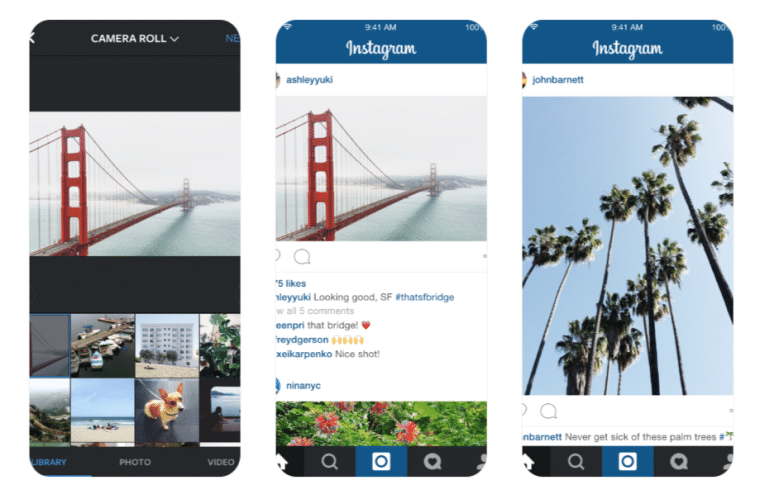
2016: Instagram Stories, Ranked Feed, and Rebrand Launched Worldwide
When it was first launched in 2010, the Instagram feed was organized chronologically. However, as more people started using Instagram, it became impossible to maintain the chronological feed.
By 2016, users were missing 70% of their posts, and not seeing friends’ posts. This is why Instagram launched an algorithm based on user engagement and activity, interaction history, and post information to show users relevant posts. Today, it still uses algorithms for Instagram Stories, Feed, Explore, Instagram Reels, and Search.
Another feature that marked 2016 was Instagram Stories, vertical photos, and videos that disappear after 24 hours. Over the next few years, Instagram introduced more features available on stories, such as enabling hashtags, links, music, and location tagging.
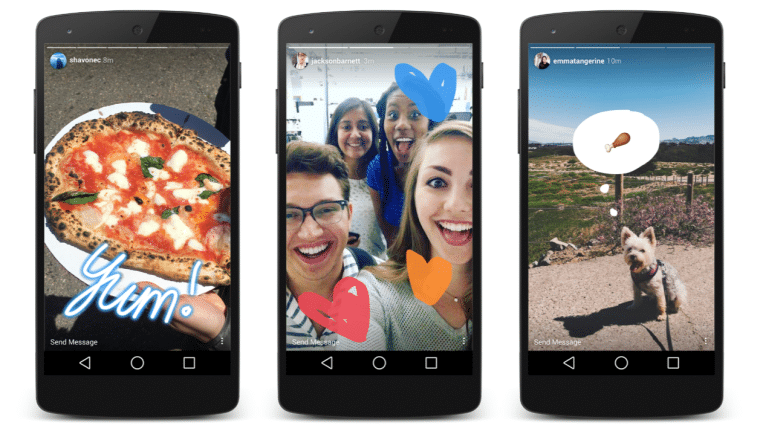
Given the major changes that happened up until this year, Instagram also went through a brand refresh, changing its logo, color palette, and typeface.
2017: Instagram Begins Carousel Posts and AR Effects
Before 2017, Instagram users could only post photos or videos one at a time. With the launch of carousel photos, the app allowed users to post up to 10 photos and videos in a single post. This feature turned out to be useful when users wanted to post photos from the same event, such as a party or a trip.
In the same year, Instagram also started AR effects, including face filters and creative stickers.
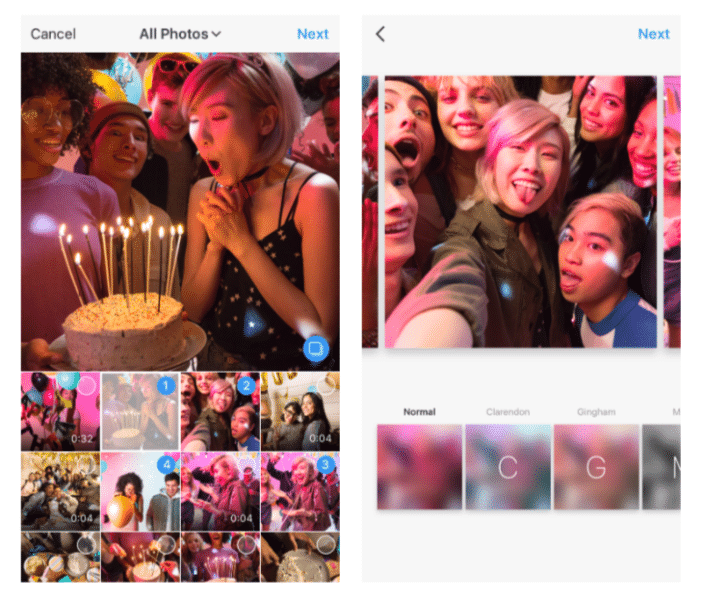
2018: Instagram Reaches 1 Billion Monthly Active Users
In 2018, the Instagram app passed an important milestone: 1 billion monthly active users. As for products, it started IGTV, a long-form vertical video platform.
Major changes occurred in the company’s corporate operations, as Kevin Systrom and Mike Krieger stepped back from their role as CEOs. Adam Mosseri became the Head of Instagram.
2019: Instagram Introduces In-App Shopping
With in-app shopping and Checkout With Instagram, business accounts were able to create shoppable posts for users to purchase products without leaving the app.
To buy a product from a shoppable post, users simply click on the photos to see the shop tag and the price. The app then shows a checkout page, where users need to enter their contact details and shipping address.
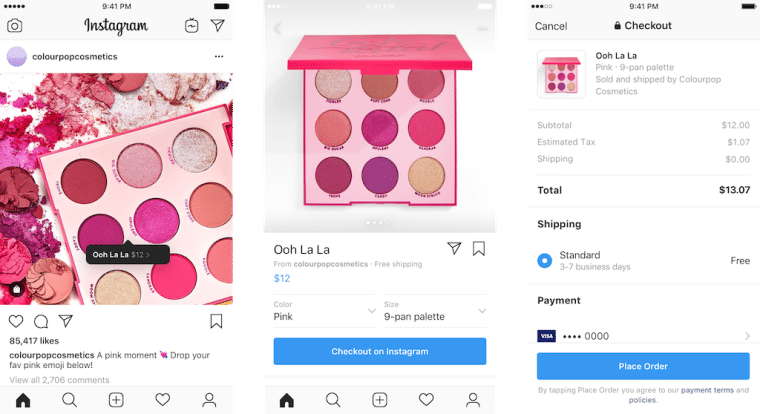
2020: Instagram Reels Start: Fun, Short-Form Videos
A major milestone in the history of Instagram, the app started Reels as a creative way of sharing short videos. In 2020, users and creators were able to post 15-second Reels using audio and visual effects.
Public accounts also had the opportunity to have their Reels distributed on the Explore page, reaching a broader audience and increasing monetization opportunities.
Since 2020, Instagram has made certain changes to Reels, such as increasing their length, but the original purpose of sharing short, entertaining videos has stayed the same. Fast forward to 2025, Instagram Reels have been trending as the most engaging content format, generating 2x more reach and impressions than carousels and photos.
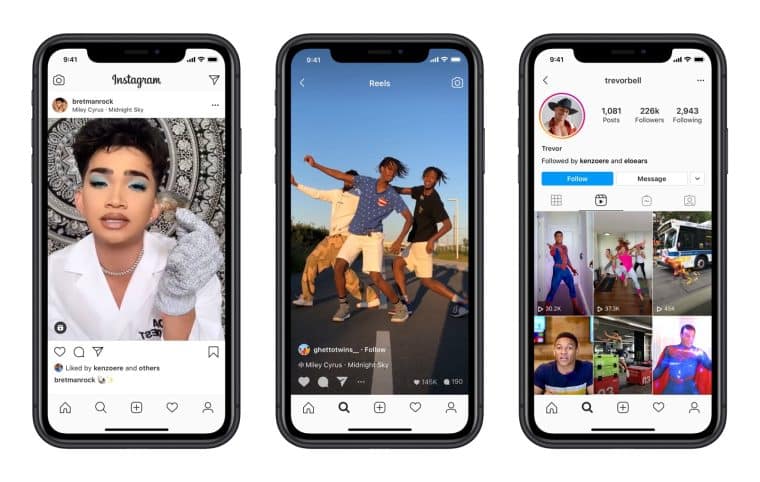
2021-2022: Instagram Decides to Focus on Creators, Videos, Shopping, and Messaging
In 2021, Adam Mosseri highlighted that Instagram was now more than a square photo-sharing app. By this time, it also moved on from its long-form IGTV brand, focusing on four key areas:
- Creators
- Video
- Shopping
- Messaging
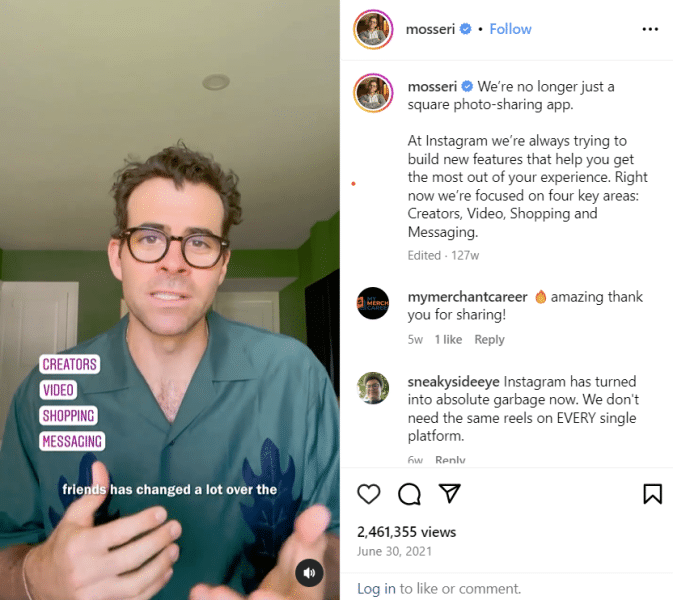
From 2021 onwards, Instagram’s new features focused on optimizing Instagram Reels videos, investing in creators, and giving users more options regarding what they want to see on their feeds and Explore pages.
2023: Instagram Launches Threads and Meta Verified
Threads launched in 2023 as Instagram’s text-based public conversation app. One of the biggest Instagram announcements of the year, the app saw 100 million users signing up in less than a week.
Users in eligible countries can join Threads using their Instagram accounts.
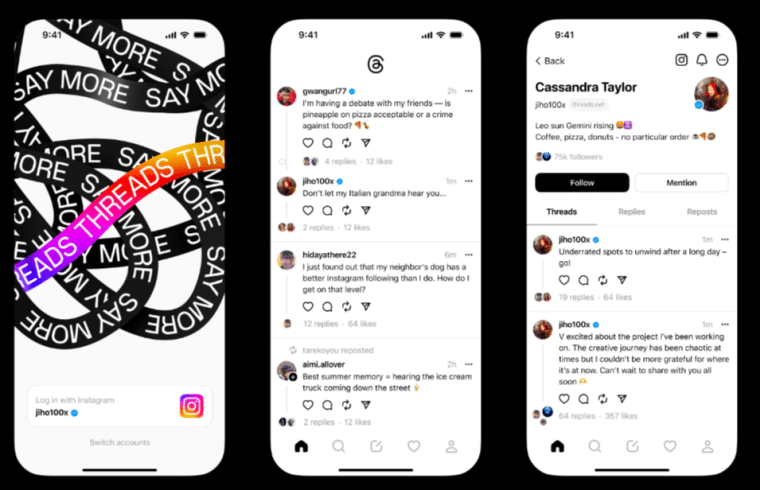
In 2023, Meta also started Meta Verified, which impacted Facebook and Instagram. To get Meta Verified on Instagram, users and creators need to pay for a monthly subscription and provide their government IDs. By subscribing, they unlock more creator benefits, account protection, and direct support.
History of the Instagram Logo
Instagram changed its logo in May 2016, replacing the vintage camera with a modern, vibrant design. This was part of a brand refresh, which also included changing the user interface, typeface, and colors.
Although Instagram started as a platform to easily edit and share photos, it had grown to be much more than that by 2016. People started sharing more videos, interacting with the Instagram community and creators, and using new Instagram tools, beyond photo sharing and editing.
Ian Spalter, Head of Design at Instagram at the time, on Medium wrote:
The Instagram icon and design was beginning to feel, well… not reflective of the community, and we thought we could make it better
Instagram’s new logo and look reflected the app’s new identity, while celebrating its creator community. During the rebrand, Instagram’s design team also updated the icons of Layout, Boomerang, and Hyperlapse, and simplified the app’s UI.
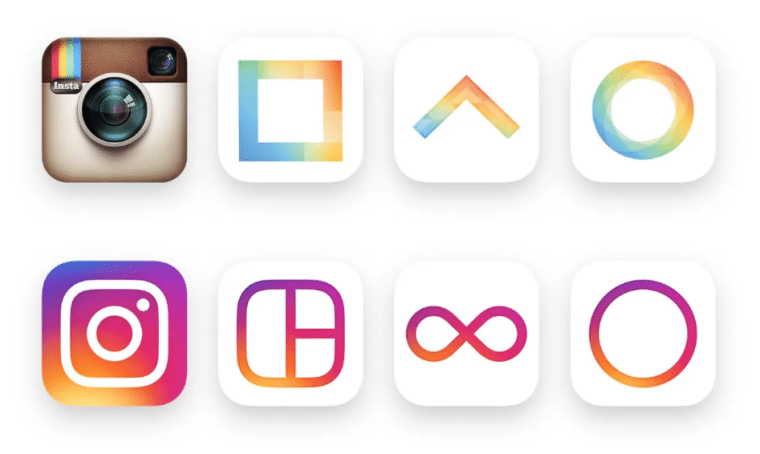
Monetization Strategies
Instagram generates revenue through a variety of monetization strategies, leveraging its vast user base and engagement levels. Key monetization methods include:
1. Advertising:
Instagram’s primary source of revenue is advertising. The platform offers several ad formats to cater to different marketing objectives:
- Photo and Video Ads: Standard ads appearing in users’ feeds.
- Stories Ads: Full-screen ads shown between user Stories.
- Carousel Ads: Allowing multiple photos or videos in a single ad.
- Explore Ads: Ads appearing in the Explore section, reaching users exploring new content.
- Shoppable Posts: Enabling businesses to tag products in posts, allowing users to purchase directly from the app.
- Reels Ads: Ads integrated into the short-form video content of Reels.
2. Shopping Features:
Instagram has integrated shopping features that allow businesses to set up virtual storefronts. Features include:
- Instagram Shop: A dedicated shopping tab for users to browse products.
- Shoppable Posts: Businesses tag products in posts, which users can click to view details and purchase.
- Checkout on Instagram: Users can buy products directly within the app without being redirected to external websites.
3. Creator Monetization:
Instagram provides tools and programs to help creators monetize their content:
- Branded Content Partnerships: Creators collaborate with brands to create sponsored content, with Instagram facilitating these partnerships.
- Instagram Creator Fund: Financial support for creators to produce engaging content.
- Badges in Live: Fans can purchase badges during live streams, providing direct financial support to creators.
- Affiliate Marketing: Creators earn commissions by promoting products and driving sales through affiliate links.
4. Subscription Services:
Instagram has introduced subscription models where users can pay for exclusive content from their favorite creators, providing a steady revenue stream for both the platform and the creators.
Educational and Professional Uses
Instagram is increasingly used for educational and professional purposes, leveraging its visual and interactive features:
1. Educational Content:
Educators and institutions use Instagram to share knowledge and resources:
- Infographics and Carousels: Simplifying complex information into visually appealing formats.
- Live Sessions and IGTV: Hosting live lectures, Q&A sessions, and educational series.
- Reels and Stories: Creating short, engaging educational videos on various topics.
2. Professional Networking:
Professionals use Instagram to build their personal brand and network with peers:
- Portfolio Showcase: Creatives like photographers, designers, and artists use Instagram as a portfolio to showcase their work.
- Industry Updates: Sharing and consuming industry news, trends, and insights.
- Networking: Connecting with other professionals, potential clients, and collaborators.
3. Business Growth:
Businesses leverage Instagram to enhance their visibility and engage with customers:
- Marketing and Advertising: Running targeted ad campaigns to reach potential customers.
- Customer Engagement: Using interactive features like polls, questions, and live videos to engage with their audience.
- Product Launches and Promotions: Announcing new products and special offers to followers.
User Support and Feedback Mechanisms
Instagram provides various channels for user support and feedback to ensure a smooth user experience:
1. In-App Help Center:
The Help Center offers comprehensive guides and FAQs on various topics, from account management to troubleshooting common issues. Users can access this resource within the app for quick assistance.
2. Reporting and Appeals:
Users can report inappropriate content, spam, and account issues directly through the app. Instagram has a streamlined process for handling these reports, including the option to appeal decisions.
3. Direct Support:
For more complex issues, Instagram offers direct support through:
- Email Support: Users can contact Instagram support via email for assistance with specific problems.
- Support Tickets: Users can submit support tickets detailing their issues, which are then addressed by the support team.
4. Feedback Channels:
Instagram encourages user feedback to improve the platform:
- In-App Surveys: Periodic surveys gather user opinions on new features and overall experience.
- Beta Testing Programs: Users can participate in beta testing for new features and provide feedback before official rollouts.
- Social Media Channels: Users often share their feedback and suggestions on Instagram’s social media profiles, which are monitored by the company.
By employing these strategies and mechanisms, Instagram continually adapts to user needs, ensuring a robust platform for both personal and professional use.
The Future of Instagram
Thanks to the extensive features it launches and updates regularly, Instagram evolved to be a go-to app for creators and brands. In 2025, its products include Reels, Stories, carousel photos, DMs, shoppable posts, ads, and many more.
Adam Mosseri regularly shares Instagram updates on his profile, and often talks about the app’s big potential for creators. In an Ask Me Anything session on Instagram Stories, he mentioned that creators would remain the priority for the future of Instagram.
As a Meta company, Instagram also uses AI technologies, which is Meta’s biggest future investment area. The use of AI in Instagram will increase given the developments regarding AI-driven feed recommendations, generative AI stickers, and the Meta AI chatbot.
